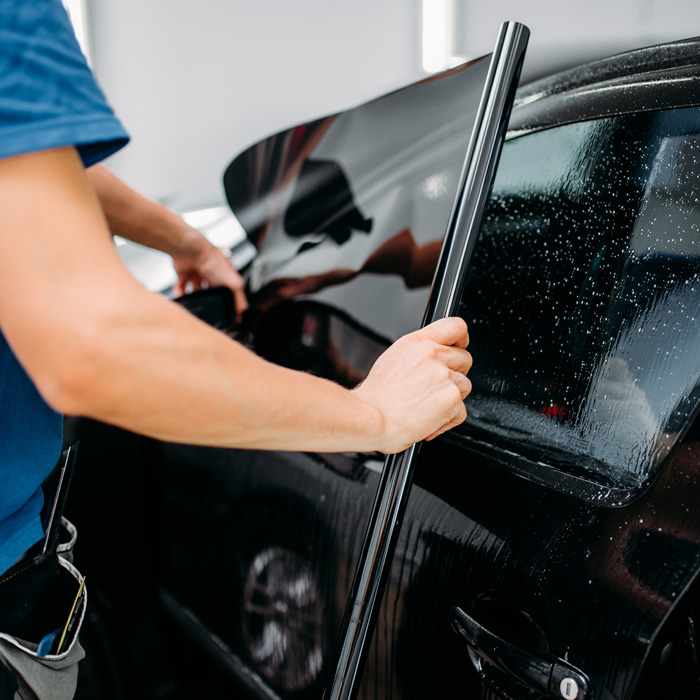Florida is called “the sunshine state” for a reason. On average, Florida has over 230 days of beautiful, bright sunshine each year. That’s why Florida has laws specifically designed to regulate the amount of tinting you can put on your car. Many people want their car windows tinted in Florida because excessive sunlight can damage the car’s interior fabric and makes getting into the car a hot nightmare. The original laws in Florida were enacted over 30 years ago, in 1991. Here is a breakdown of the car tinting laws for 2023 in Florida.
About Visible Light
Florida laws regulate the amount of VLT (or Visible Light Transmission) your car windows must allow. Florida specifically regulates the amount of light allowed into windows in cars, SUVs and vans. Usually, VLTs are reported in percentages. The visible light law is used regularly in many states across the nation, not just Florida.
Tint Regulations for Sedans
 According to Florida law, sedans are characterized as any car that has two axles and two to four car doors. Florida law for sedan window tinting says that only non-reflective tint is allowed on the front windshield of sedans. The tint must be above the AS-1 line, which represents the horizontal line five inches below the top of your windshield. The non-reflective tint is so that the reflection from the windshield does not blind drivers.
According to Florida law, sedans are characterized as any car that has two axles and two to four car doors. Florida law for sedan window tinting says that only non-reflective tint is allowed on the front windshield of sedans. The tint must be above the AS-1 line, which represents the horizontal line five inches below the top of your windshield. The non-reflective tint is so that the reflection from the windshield does not blind drivers.
In sedans, the front side windows on the driver’s and passenger’s sides have to allow more than 28% of light in. Rear passenger windows must allow more than 15% of light in. The rear windshield also must have more than 15% of light in.
Tint Regulations for SUVs and Vans
SUVs and vans have the same tint regulations because, often, their windows are designed in the same way. Just like in cars, front windshield tinting must be above the AS-1 line. Also, like in sedans, the front driver’s and passenger’s window tint must permit 28% of light in. Both the back side windows and the rear windshield can be darker in SUVs and vans than they are in sedans. You can have darker tinted rear windows and windshields that allow more than 6% of light in.
What About Reflectivity?
Florida law specifically regulates the reflectivity you need to have on your car’s windows. Like the tint regulations, the reflectivity regulations are separated into sedan regulations and SUV and van regulations.
With regard to tint reflection for sedans, Florida law states that your front side windows cannot be more than 25% reflective. Back-side windows on sedans can’t be more than 35% reflective. Although the laws separate the types of cars, the Florida laws for reflectivity on vans and SUVs are the same as for sedans. Front-side windows must not be more than 25% reflective, and back windows must be less than 35% reflective.
What About Pickups?
Pickup trucks are a breed all their own. If you own a pickup truck, your front windows must permit 28% of all light in. Your rear windows must allow 15% of all light in, and your rear windshield must let at least 6% of all light in.
Other Tint Rules to Know
There are some other rules you need to know about if you have tint on your sedan, SUV, truck, or van. If you have rear tint, you must have dual side mirrors on your vehicle. Your tint cannot be multicolored because that’s against Florida law. All vehicles must use the same dark tint. Your vehicle must have a sticker on the driver’s side door jam that identifies a legal tint. There are special considerations for people who have a medical exemption, such as people with vision issues. If you have special considerations, you’ll want to check with your Department of Motor Vehicles about tinting for your vehicle.
When you are ready to get your residential home, business, or automobile windows tinted, you need to get in touch with Sol Control Customs and Tint. Sol Control Customs has been doing business in the Tampa and New Port Richey areas for nearly 30 years. We strive to make sure our customers are satisfied and impressed with all of our work as well as the professionalism of our employees. Why not contact us today to get an estimate on your next tinting job?


